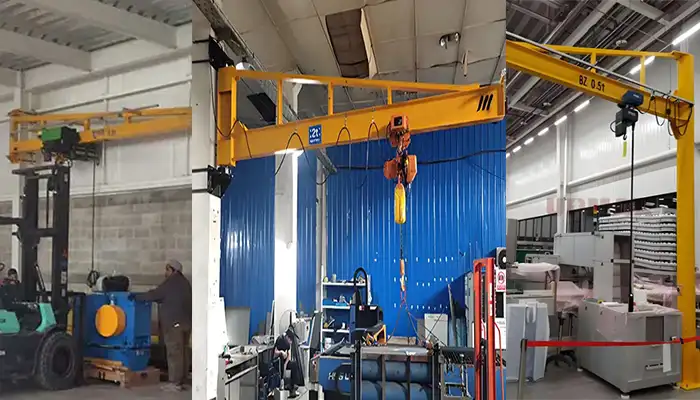
Jib Hoist for Your Pillar Jib Crane: Manual vs. Electric Hoists
Jib Hoist for Your Pillar Jib Crane: Manual vs. Electric Hoists
Compare manual & electric hoisting systems for pillar jib cranes, focusing on efficiency, load capacity & operational convenience.Get your jib hoist!
Manual vs. Electric Hoisting Systems: Choosing the Best Option for Your Pillar Jib Crane
Jib Hoisting Systems
Hoisting systems are essential tools used to lift and lower heavy loads with efficiency and precision. These systems come in various forms, including manual and electric models, each designed to handle different lifting requirements. At their core, hoisting systems use a combination of mechanical or electrical components to move loads vertically. They play a critical role in numerous industries, including manufacturing, construction, and logistics, where safe and effective load handling is crucial.
Importance in Pillar Jib Cranes
Pillar jib cranes are versatile lifting machines mounted on a vertical column, with a horizontal arm or jib that extends to support the load. The choice of hoisting system—manual or electric—significantly impacts the crane’s performance and suitability for various tasks.
In pillar jib cranes, the hoisting system directly influences the crane’s operational efficiency, speed, and ease of use. Manual hoisting systems might be sufficient for smaller, less frequent lifting tasks where simplicity and cost are priorities. However, electric hoisting systems offer advantages in high-capacity or high-frequency applications, where speed and precision are essential.
Manual Hoisting Systems
Manual hoisting systems are designed to lift and lower loads through human effort. These systems rely on mechanical components such as hand chains, gears, and pulleys to achieve lifting operations. Unlike electric hoisting systems, manual hoists do not require a power source and are operated by hand-cranking or pulling a chain. This type of hoisting system is often used in environments where electrical power is unavailable or where a more straightforward, low-cost solution is preferred.
Basic Operation and Components
Manual hoisting systems typically consist of the following key components:
- Hand Chains: These are used to manually raise or lower the load. The user pulls the chain to engage the hoist mechanism.
- Gears: Gears within the hoist convert the manual force applied through the hand chain into lifting power. They provide the mechanical advantage needed to lift heavy loads.
- Pulleys: Pulleys help to guide and support the lifting chain or rope, reducing friction and ensuring smooth operation.
- Brake System: Many manual hoists include a braking system to hold the load in place once it has been lifted to the desired height.
Advantages
- Cost-effectiveness: Manual hoisting systems are generally more affordable than electric models. They do not require electrical wiring or power sources, which reduces both initial purchase and installation costs.
- Simplicity and Ease of Maintenance: These systems have fewer moving parts and do not rely on electrical components, making them simpler to maintain and repair. Routine maintenance typically involves checking and lubricating mechanical parts.
- Suitability for Lower Lifting Capacities: Manual hoists are ideal for tasks involving lower lifting capacities and less frequent use. They are well-suited for environments where lifting needs are minimal and where simplicity and cost savings are prioritized.
Disadvantages
- Physical Effort Required: Operating a manual hoisting system requires physical effort from the user, which can be strenuous, especially when lifting heavy loads or performing frequent lifting tasks. This manual effort can also lead to operator fatigue.
- Limited Lifting Speed and Efficiency: Manual hoists are generally slower and less efficient compared to electric hoisting systems. The lifting speed is dependent on the operator's strength and pace, which can impact productivity in high-demand settings.
- Inconsistent Lifting Precision: Achieving precise control over load positioning can be challenging with manual systems. Variations in operator effort can lead to inconsistent lifting heights and potential difficulty in achieving accurate load placement.
Jib Hoists System of Pillar Jib Cranes
Slewing motion of slewing pillar jib crane can be operated manually or electrically.
Various type of jib hoist options are available for pillar mounted jib cranes, such as, manual jib hoist, geared trolley jib hoist,, electrical chain hoist, motorized trolley jib hoist and other types of jib hoist designs, etc.
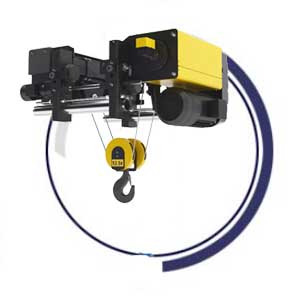
European Style Electric Hoist
The jib hoists are applicable for various types of single girder overhead travelling crane, single beam crane, H beam crane, I beam crane, monorail crane, and other types of single girder cranes, etc.
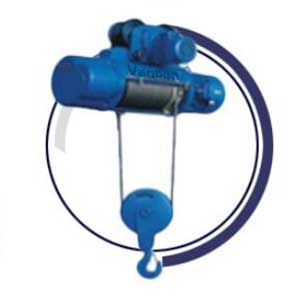
Chinese Style Electric Wire Rope Hoist
The Chinese type jib hoists are applicable for various types of single girder overhead travelling crane, single beam crane, H beam crane, I beam crane, monorail crane, and other types of single girder cranes, etc.
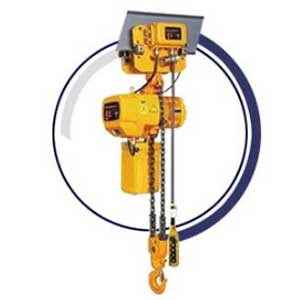
Electric Trolley Electric Chain Hoist
Types of jib crane hoist designes are available for your single girder overhead travelling crane. Contact us to get your overhead crane design and good overhead crane price.
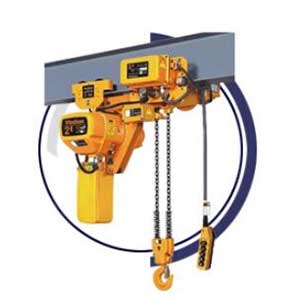
Low Headroom Electric Chain Hoist
Types of jib crane hoist designes are available for your single girder overhead travelling crane. Contact us to get your overhead crane design and good overhead crane price.
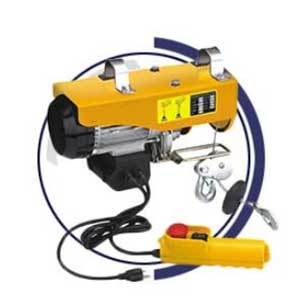
Mini Small Electric Chain Hoist with Single Phase
Mini electric wire ropes hoists - fixed hoist design & electric trolley type- 0.2 ton- 1 ton mini rope lift, single phase mini electric hoists, cheap small hoist for sale.
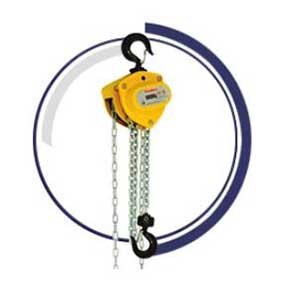
Manual and Hand Chain Hoist & Chain Block
Manual chain block & manual chain hoist for sale. Light,economical & handy manual hoists & hand hoists of 250kg, 1 ton, 1.5 ton , 2 ton , 3 ton , 4 ton , 5 ton , 6 ton,etc.
Electric Hoisting Systems
Electric hoisting systems use electrical power to automate the lifting and lowering of loads. These systems are designed to handle heavier loads and provide faster, more precise operations compared to manual hoists. By employing electric motors and advanced control mechanisms, electric hoists reduce the physical effort required by operators and enhance overall efficiency in lifting operations.
Basic Operation and Components
Electric hoisting systems consist of several key components:
- Electric Motors: The core of the electric hoisting system, electric motors provide the power necessary to lift and lower loads. These motors are connected to gear mechanisms that convert electrical energy into mechanical lifting force.
- Control Panels: Control panels allow operators to manage the hoist's functions, including lifting, lowering, and stopping the load. They often include buttons or switches to control the motor and may feature additional controls for speed adjustment and safety features.
- Gears and Pulleys: Similar to manual systems, electric hoists use gears and pulleys to facilitate smooth and efficient load movement. However, in electric systems, these components work in conjunction with the motor to enhance performance.
- Brake System: Electric hoists typically include an automated braking system that holds the load securely in place when not in motion. This system ensures safety and stability during operations.
Advantages
- High Lifting Efficiency and Speed: Electric hoisting systems offer superior lifting speed and efficiency. The electric motor provides consistent power, allowing for rapid lifting and lowering of loads, which can significantly boost productivity in high-demand environments.
- Consistent and Precise Control: Electric hoists deliver precise control over load positioning and movement. Operators can achieve accurate and consistent results with minimal effort, which is especially beneficial for tasks requiring exact load placement.
- Suitable for Higher Lifting Capacities and Frequent Use: Electric hoists are well-suited for heavy-duty applications and frequent use. Their robust design and high power output enable them to handle larger loads and withstand continuous operation without compromising performance.
Disadvantages
- Higher Initial Cost: The initial investment in electric hoisting systems is typically higher than that for manual hoists. The cost of the hoist itself, along with installation and wiring requirements, contributes to the higher expense.
- Requires Power Supply and Regular Maintenance: Electric hoists need a reliable power supply to operate. Additionally, they require regular maintenance to ensure optimal performance and longevity, including checking electrical components and addressing any potential issues.
- Potential for Electrical Issues and Complex Repairs: Electric hoisting systems are more complex than manual systems and can encounter electrical issues or malfunctions. Repairs may require specialized knowledge and parts, making them potentially more challenging and costly to fix compared to simpler manual systems.
Key Considerations for Choosing Between Manual and Electric Hoisting Systems
Load Capacity and Frequency of Use
- Assessing the Typical Load Requirements: The load capacity required is a crucial factor in choosing between manual and electric hoisting systems. Manual hoists are generally suitable for lighter loads, typically up to a few tons. For applications involving heavier loads, electric hoists are more appropriate due to their higher lifting capacities. Evaluate the maximum load you need to handle regularly to ensure the hoisting system you choose can meet these demands without strain or reduced performance.
- Determining the Frequency of Lifting Operations: The frequency with which lifting operations are performed will impact the choice of hoisting system. Manual hoists are more practical for infrequent or intermittent lifting tasks, where their slower operation and physical effort are manageable. In contrast, electric hoists excel in environments where lifting occurs frequently or continuously, as they offer faster and more efficient operation, reducing the time and effort required for each lift.
Work Environment
- Impact of Environment on System Choice: The operating environment plays a significant role in the selection of hoisting systems. For environments with extreme temperatures, high humidity, or corrosive substances, electric hoists may require additional protection and maintenance. Manual hoists, while simpler, may also face limitations in harsh conditions, but they are generally more adaptable to diverse environments. Assess the environmental conditions of your workplace and consider any additional protective measures or features needed for the hoisting system you choose.
- Considerations for Safety and Ergonomics: Safety is paramount in any lifting operation. Electric hoists generally offer enhanced safety features such as automatic braking systems and overload protection, which can reduce the risk of accidents. Ergonomically, electric hoists minimize physical strain on operators, which is important in preventing fatigue and injuries. Manual hoists, while simpler, require more physical effort, which may not be ideal for prolonged use. Evaluate the safety and ergonomic requirements of your workplace to ensure the chosen system aligns with these needs.
Cost Factors
- Initial Investment vs. Long-term Operational Costs: The cost of purchasing a hoisting system involves both the initial investment and long-term operational expenses. Manual hoists typically have a lower upfront cost, making them a cost-effective choice for budget-conscious projects. However, electric hoists, despite their higher initial cost, can offer greater efficiency and productivity, potentially reducing long-term operational costs. Consider the total cost of ownership, including energy consumption, maintenance, and potential downtime, when making your decision.
- Maintenance and Repair Expenses: Regular maintenance and repair costs are important factors to consider. Manual hoists usually require less specialized maintenance and are less prone to complex failures, leading to lower repair costs. Electric hoists, on the other hand, involve more intricate components and may require specialized technicians for repairs, which can increase maintenance expenses. Assess the long-term maintenance and repair needs of each system to ensure they align with your operational budget and capabilities.
Ease of Use and Training Requirements
- Training Needs for Manual vs. Electric Systems: Training requirements vary between manual and electric hoisting systems. Manual hoists generally require less extensive training, focusing on basic mechanical operation and safety procedures. Electric hoists involve more complex controls and may require operators to be trained in handling electrical components and advanced features. Ensure that your team has the necessary training to operate the chosen system safely and effectively.
- User Comfort and Productivity: The ease of use and impact on user comfort are important considerations. Electric hoists significantly reduce physical effort, leading to higher operator comfort and potentially increased productivity. Manual hoists, while simpler, require more physical exertion, which can affect operator comfort and efficiency, especially during frequent or heavy lifting tasks. Evaluate how the hoisting system will affect your team’s comfort and productivity to make an informed decision that supports both operational efficiency and employee well-being.
Case Studies and Examples
Manual Hoisting System Case Study
Real-world Example of Successful Manual System Application
Case Study: Small Manufacturing Workshop
In a small metal fabrication workshop, a manual hoisting system was employed to handle routine lifting tasks of metal sheets and parts. The workshop, which primarily handles light to moderate loads, chose a manual chain hoist due to budget constraints and the infrequent nature of their lifting needs.
Benefits and Challenges Faced
Benefits:
- Cost Savings: The manual hoist's lower purchase and installation costs fit the workshop’s budget, allowing them to allocate resources to other areas of their operations.
- Simplicity and Reliability: The manual hoist proved to be straightforward to operate and maintain. Its simple mechanical design resulted in fewer breakdowns and lower maintenance costs.
- Flexibility: The absence of electrical components made the manual hoist versatile and suitable for use in various workshop environments without concerns about power supply or electrical hazards.
Challenges:
- Physical Effort: Operators faced physical strain from manually pulling the chain, especially during heavy or repeated lifts, which led to fatigue and reduced productivity during peak times.
- Limited Speed and Precision: The lifting speed was slower compared to electric systems, and achieving precise load positioning required careful manual handling, affecting overall efficiency.
- Manual Operation Constraints: The manual hoist was less suitable for tasks requiring high lifting frequency, leading to potential delays in production during busy periods.
Electric Hoisting System Case Study
Real-world Example of Successful Electric System Application
Case Study: Automotive Assembly Line
An automotive manufacturing plant implemented an electric hoisting system to manage the lifting and positioning of engine components along their assembly line. Given the high volume of parts and the need for precise, rapid lifting, the plant chose an electric overhead hoist with integrated control panels and safety features.
Benefits and Challenges Faced
Benefits:
- High Efficiency and Speed: The electric hoist significantly increased lifting speed and operational efficiency, allowing the plant to maintain a high production rate and reduce cycle times.
- Precision and Control: The advanced control system provided precise load positioning and smooth operation, crucial for aligning engine components accurately during assembly.
- Reduced Operator Fatigue: With the electric system handling the heavy lifting, operators experienced less physical strain, leading to improved comfort and productivity.
Challenges:
- Higher Initial Cost: The electric hoist system involved a substantial initial investment, including the cost of installation and integration into the existing assembly line.
- Power Supply and Maintenance: The system required a stable power supply and regular maintenance to ensure reliable operation. Electrical components needed periodic checks to prevent issues and ensure longevity.
- Complexity in Repairs: When issues arose, repairs required specialized knowledge and expertise, leading to potentially higher costs and longer downtimes compared to simpler manual systems.
These case studies highlight how the choice between manual and electric hoisting systems depends on specific operational needs, budget constraints, and the desired balance between efficiency and cost. Each system offers unique advantages and challenges that must be considered to ensure optimal performance in different industrial contexts.
Making the Decision
Factors to Consider
When choosing between manual and electric hoisting systems, several key factors should guide your decision:
- Load Capacity and Frequency of Use: Assess the typical loads and how often lifting operations are performed. Electric hoists are better for higher capacities and frequent use, while manual hoists are suitable for lighter loads and less frequent tasks.
- Work Environment: Consider environmental conditions such as temperature, humidity, and potential exposure to corrosive substances. Electric hoists may require additional protection in harsh environments, while manual hoists are generally more adaptable but may face limitations in extreme conditions.
- Cost Factors: Compare the initial investment and long-term operational costs. Manual hoists have a lower initial cost but may involve more physical labor and potential inefficiencies. Electric hoists, while more expensive upfront, offer greater efficiency and reduced manual effort, potentially lowering long-term costs.
- Ease of Use and Training Requirements: Evaluate the ease of operation and the training required for each system. Electric hoists typically require more training due to their complexity, whereas manual hoists are simpler but require physical effort from operators.
How to Weigh the Pros and Cons Based on Specific Needs
To make an informed decision, weigh the pros and cons of each hoisting system in relation to your specific operational needs:
- For High-Capacity and High-Frequency Use: Electric hoists are preferable due to their speed, precision, and ability to handle larger loads efficiently. Consider the higher initial investment and maintenance needs as part of your decision-making process.
- For Low-Capacity and Infrequent Use: Manual hoists may be more cost-effective and simpler to maintain, making them suitable for environments where heavy lifting is less frequent and budget constraints are a concern.
- For Harsh or Specialized Environments: Assess if additional features or protections are needed. Electric hoists may need extra safeguarding in harsh environments, while manual hoists might be more resilient but less efficient.
- For Ergonomics and Operator Comfort: If operator comfort and reducing physical strain are priorities, electric hoists offer significant advantages in terms of reducing manual effort and improving productivity.
Consultation and Expert Advice
Consulting with Experts
Consulting with industry experts is crucial for selecting the most appropriate hoisting system for your needs. Experts can provide valuable insights based on their experience, helping you navigate the complexities of different systems and avoid common pitfalls. They can assess your specific requirements, such as load capacities, environmental conditions, and operational goals, to recommend the best solution tailored to your situation.
How to Seek Professional Guidance
- Identify Qualified Consultants: Look for experts or consultants with experience in hoisting systems and a track record of working with similar applications. Industry associations or manufacturers can often provide recommendations for reputable professionals.
- Request Detailed Consultations: Arrange consultations to discuss your specific needs in detail. Provide information about your operational requirements, work environment, and budget constraints to receive tailored advice.
- Review Case Studies and References: Ask for case studies or references from previous clients to understand how the consultant's recommendations have benefited others in similar situations.
- Evaluate Recommendations and Proposals: Carefully review the recommendations provided, considering both the technical and financial aspects. Ensure that the proposed solution aligns with your operational goals and provides a clear path for implementation.
By considering these factors and seeking expert advice, you can make a well-informed decision that optimizes the performance and efficiency of your hoisting system, ensuring it meets your operational needs and budget constraints effectively.
Conclusion
In selecting manual and electric hoisting systems, it's essential to understand their distinct characteristics and applications:
- Manual Hoisting Systems: These systems rely on manual effort, using components such as hand chains, gears, and pulleys. They are cost-effective, simple to maintain, and suitable for lower lifting capacities and less frequent use. However, they require physical effort, offer limited speed and precision, and may not be ideal for high-frequency lifting tasks.
- Electric Hoisting Systems: Electric hoists use electric motors and control panels to automate lifting operations, providing high efficiency, speed, and precision. They are suited for higher lifting capacities and frequent use but involve a higher initial investment, require a stable power supply, and may need more complex maintenance and repairs.
When choosing between manual and electric hoisting systems, consider your specific needs including load capacity, frequency of use, work environment, cost factors, and ease of use. Manual hoists may be more suitable for low-capacity, infrequent tasks where cost is a major concern. Electric hoists are better for high-capacity, high-frequency operations where efficiency, precision, and reduced physical effort are prioritized. Balancing these factors with your operational requirements and budget constraints will help you make the most suitable choice for your hoisting needs.
Emerging Technologies and Advancements in Hoisting Systems
The hoisting industry is experiencing rapid advancements that aim to enhance efficiency, safety, and functionality:
- Smart Hoisting Systems: Integration of IoT technology allows for remote monitoring and control of hoisting systems. These smart systems can provide real-time data on performance, load conditions, and maintenance needs, improving overall operational management.
- Enhanced Safety Features: Innovations in safety include advanced sensor technologies and automated safety systems that detect and prevent overloads, enhance load stability, and improve operator safety.
- Energy-Efficient Solutions: New designs and technologies are focusing on reducing energy consumption and improving the environmental footprint of hoisting systems. This includes developments in more efficient electric motors and regenerative braking systems that capture and reuse energy.
- Automation and Robotics: The integration of robotics and automated systems is becoming more prevalent, offering greater precision and reducing the need for manual intervention. This trend is particularly useful in industries with high-volume or complex lifting tasks.
- Improved Materials and Durability: Advances in materials science are leading to more durable and lightweight components that enhance the lifespan and reliability of hoisting systems, even in harsh environments.
As technology continues to evolve, staying informed about these trends and innovations will help ensure that you choose a hoisting system that not only meets your current needs but also aligns with future advancements and industry standards.
Additional Resources
Glossary of Terms
- Hoisting System: Equipment used for lifting and lowering loads. It includes both manual and electric mechanisms to achieve these functions.
- Manual Hoist: A type of hoisting system operated by hand, typically using chains or ropes and gears.
- Electric Hoist: A hoisting system powered by electricity, using motors and control panels to lift and lower loads.
- Load Capacity: The maximum weight a hoisting system can safely handle.
- Control Panel: A component in electric hoists that allows operators to control lifting, lowering, and other functions.
- Pulley System: A set of wheels and ropes or chains used to change the direction of force and reduce the effort needed to lift a load.
- Regenerative Braking: A system in electric hoists that captures and reuses energy during braking to improve efficiency.